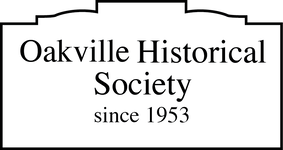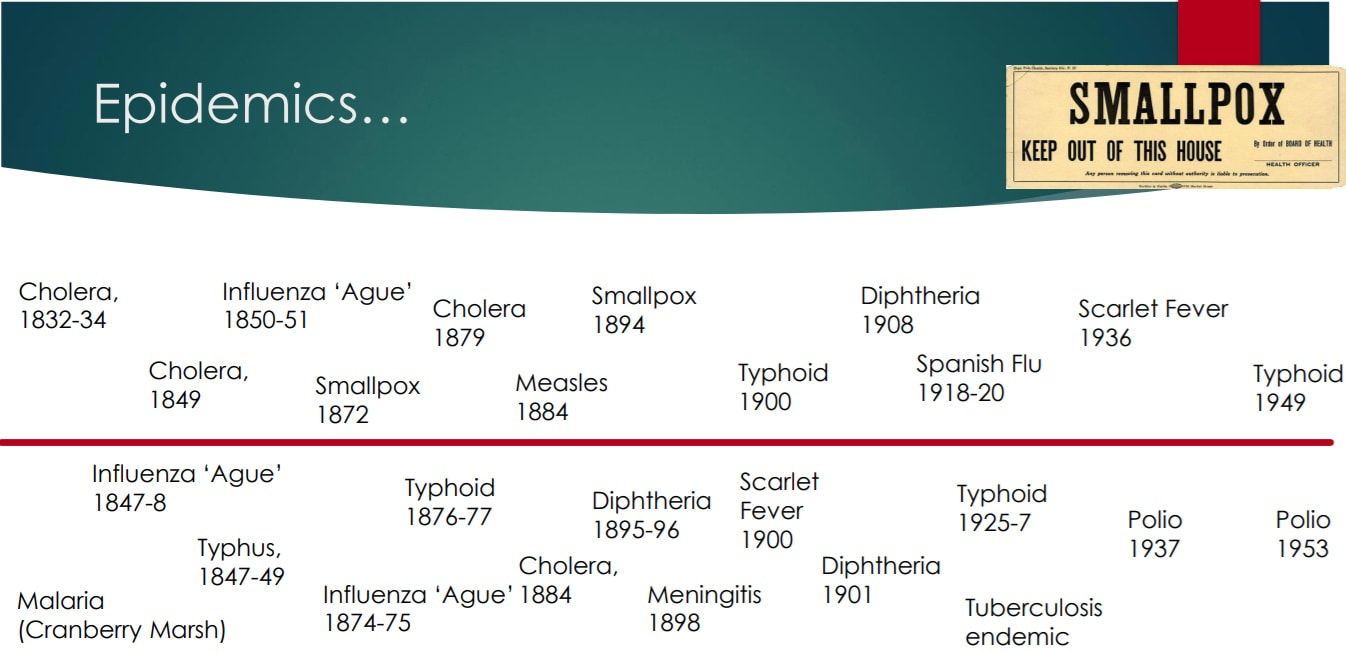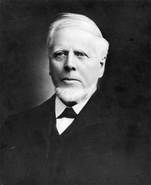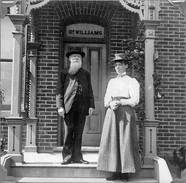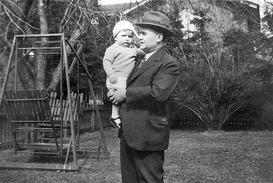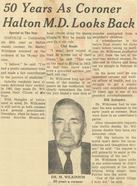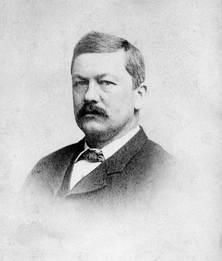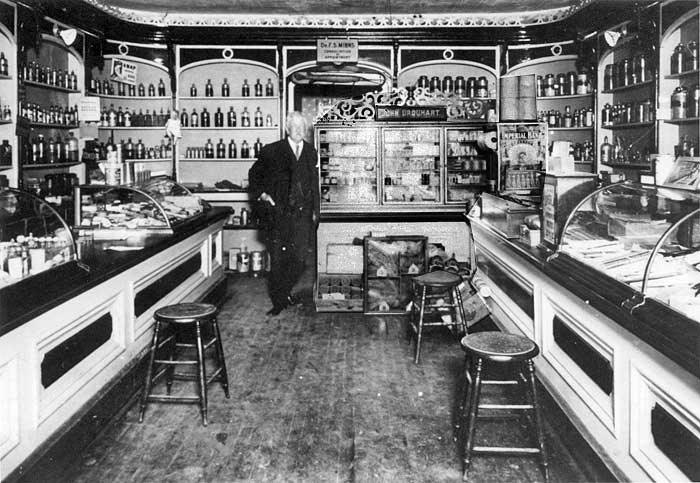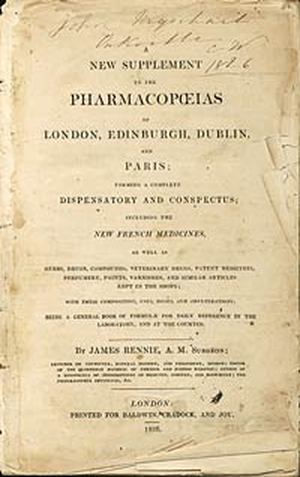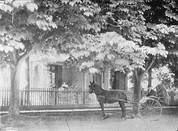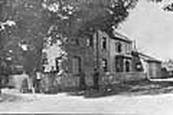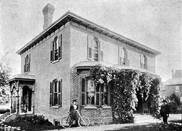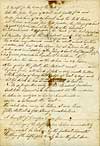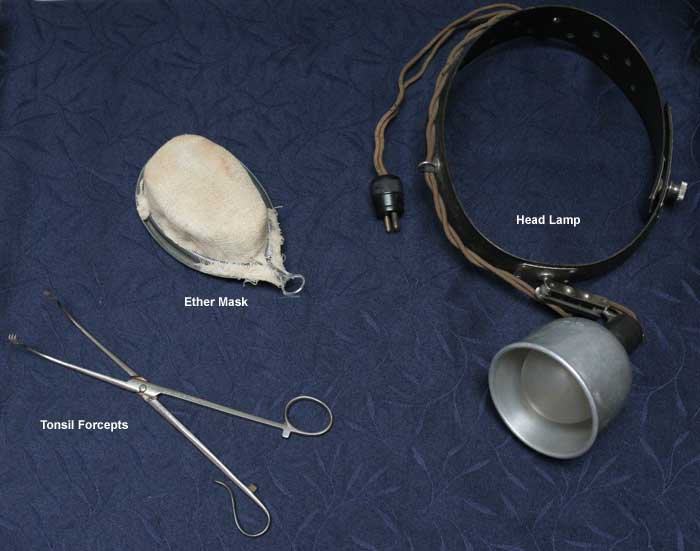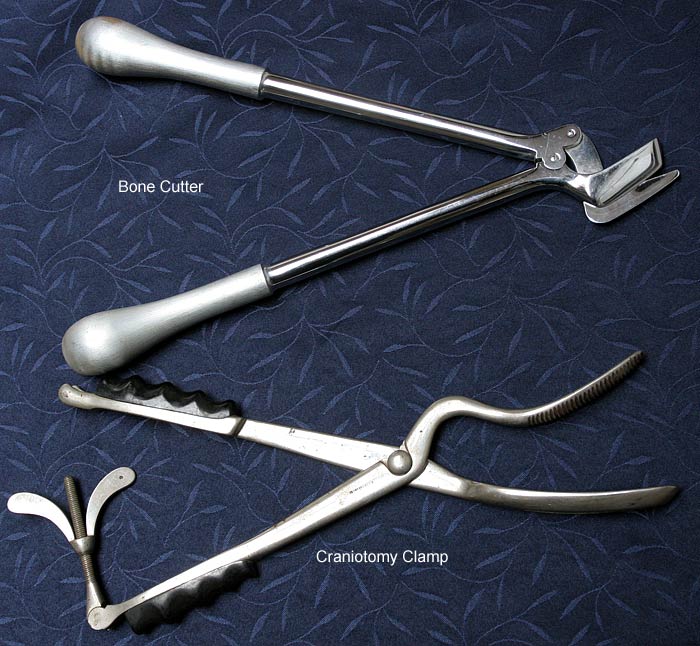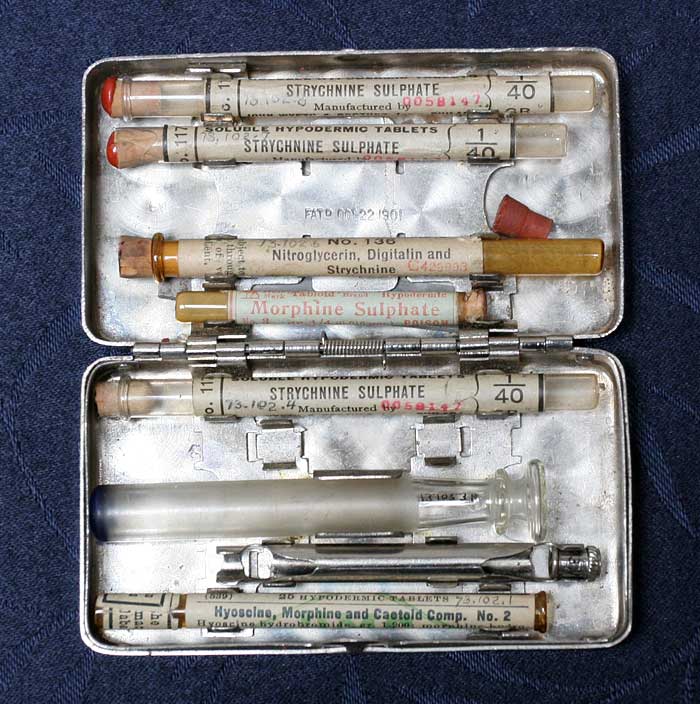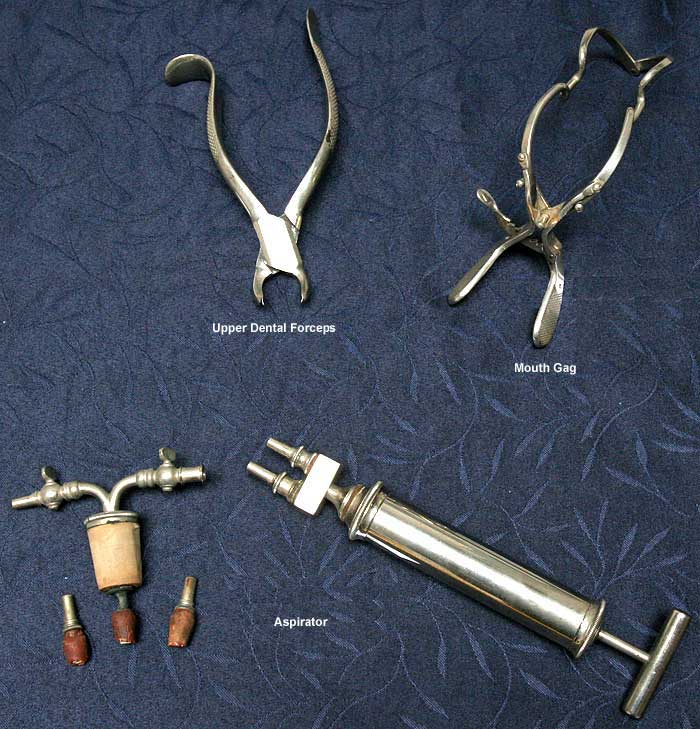|
|
The display cases in the Oakville Historical Society archives are always filled with one or more exhibits relating to Oakville's historical heritage. They're free for viewing by the public anytime our offices are open (1:00 - 4:30pm. every Tuesday and Thursday, plus the third Sunday of each month).
The following material is based on an exhibit by volunteers Mary Noad and Rosemary Seeton. They focused on health care practitioners and practices, as it was from the early 1800s to the early/mid 1900s. Much of the textual material is drawn from Hazel Chisholm Matthew's Oakville and the Sixteen. |

Early Background:
A few short years after coming into existence the settlement at the mouth of the Sixteen (that was to become Oakville) suffered its first serious healthcare crisis: an epidemic of Asiatic cholera. The cholera arrived by ship along with immigrants from Britain, where the disease had spread from Europe. Conditions on those ships were horrendous in terms of crowding and sanitation, and food supplies (provided by the immigrants themselves) rarely lasted the two-month voyage. Conditions were ripe for the spread of disease and the immigrants, wasted by starvation, died by the hundreds. |
Not all epidemics are listed. Many of these were experienced across North America.
The graphic is courtesy of the Port Colborne Historical & Marine Museum.It was shared during our Speakers' Nights. |
Boards of Heath were established at every landing place for ships, and in June 1832 Oakville's Board appointed Dr. Daniel Black as Health Inspector for all immigrant-carrying vessels arriving at Oakville and Burlington Bay. In August 1833 Dr. Black was dead of cholera.
During this time John Urquhart arrived in Oakville from Scotland via New York. He was put in charge of a new hospital set up on the west side of the Sixteen and, after two years amongst cholera victims both at York and Oakville, he was considered qualified to practice medicine. He remained in Oakville when the epidemic subsided and built a combined apothecary's shop, surgery, and dwelling to which he gave the name "Medical Hall", a popular term during this period. In 1991, the building was designated of historical significance. This building still stands as 182 Lakeshore Road East and here his son, also named John who was to become an apothecary and then Doctor, was born in 1844.
Oakville suffered other epidemics that periodically swept the country. After the scourge of cholera in the thirties came typhus in 1847, carried by immigrants trying to escape the wretchedness caused by the Industrial Revolution and the potato famine in Ireland, and in 1854 cholera returned again.
Apart from the periodic country-wide epidemics, other diseases took their toll. The burial registers of Oakville churches show that infant mortality was very high, particularly among children under two years of age. “Malignant throat”, which we know to be diphtheria, in a few days wiped out a family of six between the ages of 2 months and 19 years.
The fever known as “ague” and “malaria”, which was the scourge of early settlers in Canada, was very prevalent in Oakville. Ague was associated with swamps and marshes, although it was not then known to be carried by mosquitoes. Since no screening was used it was just as well that night air was believed injurious and all outside air best left outside.
Justus W. Williams operated a store on Colbourn Street. The store offered "a general assortment of dry goods and hardware, also a few groceries and medicines". He inscribed in his shop ledger (1830-36) his remedies for Ague, colds, Scarlet Fever, bowel complaints of every kind, etc. He also produced a transcription (slipperyjohn bark = elm bark).
Colbourn Street was latter renamed Lakeshore. The store was located at 266 Lakeshore Road East. It was the Thyme Restaurant and Wine Bar for many years. Later it became De Stefano's Ristorante. At the time of this update, it is Borgo Antico Cucina Bar.
Oakville Physicians 1830 - 1930:
During this time John Urquhart arrived in Oakville from Scotland via New York. He was put in charge of a new hospital set up on the west side of the Sixteen and, after two years amongst cholera victims both at York and Oakville, he was considered qualified to practice medicine. He remained in Oakville when the epidemic subsided and built a combined apothecary's shop, surgery, and dwelling to which he gave the name "Medical Hall", a popular term during this period. In 1991, the building was designated of historical significance. This building still stands as 182 Lakeshore Road East and here his son, also named John who was to become an apothecary and then Doctor, was born in 1844.
Oakville suffered other epidemics that periodically swept the country. After the scourge of cholera in the thirties came typhus in 1847, carried by immigrants trying to escape the wretchedness caused by the Industrial Revolution and the potato famine in Ireland, and in 1854 cholera returned again.
Apart from the periodic country-wide epidemics, other diseases took their toll. The burial registers of Oakville churches show that infant mortality was very high, particularly among children under two years of age. “Malignant throat”, which we know to be diphtheria, in a few days wiped out a family of six between the ages of 2 months and 19 years.
The fever known as “ague” and “malaria”, which was the scourge of early settlers in Canada, was very prevalent in Oakville. Ague was associated with swamps and marshes, although it was not then known to be carried by mosquitoes. Since no screening was used it was just as well that night air was believed injurious and all outside air best left outside.
Justus W. Williams operated a store on Colbourn Street. The store offered "a general assortment of dry goods and hardware, also a few groceries and medicines". He inscribed in his shop ledger (1830-36) his remedies for Ague, colds, Scarlet Fever, bowel complaints of every kind, etc. He also produced a transcription (slipperyjohn bark = elm bark).
Colbourn Street was latter renamed Lakeshore. The store was located at 266 Lakeshore Road East. It was the Thyme Restaurant and Wine Bar for many years. Later it became De Stefano's Ristorante. At the time of this update, it is Borgo Antico Cucina Bar.
Oakville Physicians 1830 - 1930:
|
1850's
1860's 1870 - 1880 1900's 1915 1920 - 1930 |
Dr. Edwy Ogden - also acted as local dentist, and practiced for over 20 years
Dr. James Johnson Dr. Anson Buck - Palermo Dr. Van Norman - Bronte Dr. John Urquhart - initially trained as druggist and in 1882 became a physician and practiced until 1920's when he was in his 90's. Also ran Dr. Urquhart's Medical Hall. Dr. Justus Samuel Williams Dr. Charles Lusk Dr. Robert O. Fisher Dr. John H. Stead Dr. Fred Sparling Dr. Morely Wilkinson Dr. Charles Page Dr. Eric Soanes - moved his office into the Medical Arts Building at Reynolds and MacDonald and was later instrumental in establishing the Lions Club first temporary hospital on First Street, then in 1950 The Oakville Trafalgar Memorial Hospital. Dr. Chesley Oake Dr. Brock Chisholm (1896 - 1971) - the first Director-General of the World Health Organization (WHO) from 1948 - 1953 and Deputy Minister of Health for Canada (1944-1946). During the six years he practiced in Oakville, his office was in the building that still stands (2008) on the south-east corner of Lakeshore and Reynolds. Click here for different linked information about Dr. Chisholm. |
Physicians and Surgeons in Oakville in 1953 (when Oakville was still a comparatively small town):
|
Dr. W.L. Anderson
Dr. R.D. Appleford Dr. A.C. Bremner Dr. D.H. Dixon Dr. R.N. Hines |
Dr. D.S. Kober
Dr. M.E. Lunau Dr. Campbell MacArthur Dr. G.K. Phillips Dr. A.E. Ross |
Dr. E.P. Soanes
Dr. F.N. Sparling Dr. F.W. Wallace Dr. G.O Warr |
Dr. Bruce Wells
Dr. W.M. Wilkinson Dr J.C. Worrell Dr. J. Zaborowska |
Today (2008) Oakville has over 200 doctors registered at Oakville Trafalgar Memorial Hospital.
(Click any image for a larger version)
(Click any image for a larger version)
|
Young John Urquhart had preferred the life of a sailor; and in 1860, at the age of sixteen, ran away from home to go on the lakes. But before John Urquhart senior died in 1867 (“a very large funeral – twenty-six teams”, observed George Sumner) he had the satisfaction of knowing that young John had bowed to his parents’ wishes and entered upon a medical career. "Young John's" first instructor was Dr. John Rolph, a supporter of Mackenzie during the Rebellion. John Urquhart graduated with honours from the University of Toronto and returned to practice at Oakville for a time before going to Edinburgh for a post-graduate course. When he died at the age of ninety, in the house where he was born, Dr. John Urquhart was reputedly the oldest practicing physician in the province. Urquhart’s and Gulledge’s were the oldest concerns in the town when, within a few years of each other, they were discontinued. The chemist’s shop had done business for just onto a century, and the harness shop for 104 years.
|
|
Mrs. McCleary gives us this account of her father’s part in the serious smallpox epidemic of 1907:
“Father was the one who recognized the first case as being smallpox and soon it had spread all over town. He had a ‘camp’ set up on the west side of the river, on the lakefront near Holyrood, and everyone who developed the disease had to be taken there until they were better. The patients were picked up one by one and driven through town by horse and wagon (resembling a ‘lumber-wagon’) to the camp, where they were looked after. When people way one of these wagons, they know it was a case of smallpox and took care not to go near. I do not know how many contracted the disease, nor how long the camp was necessary, because Father decided to take the precaution of sending me away, and I was out of Oakville when the epidemic was at its worst.” |
|
Click on the image to the left for a readable look at a few pages from an 1826 pharmacopoeia - this one having belonged to Dr. John Urquhart and donated to the Society by his great great grandson, Dr. Gerald Colemen.
|
